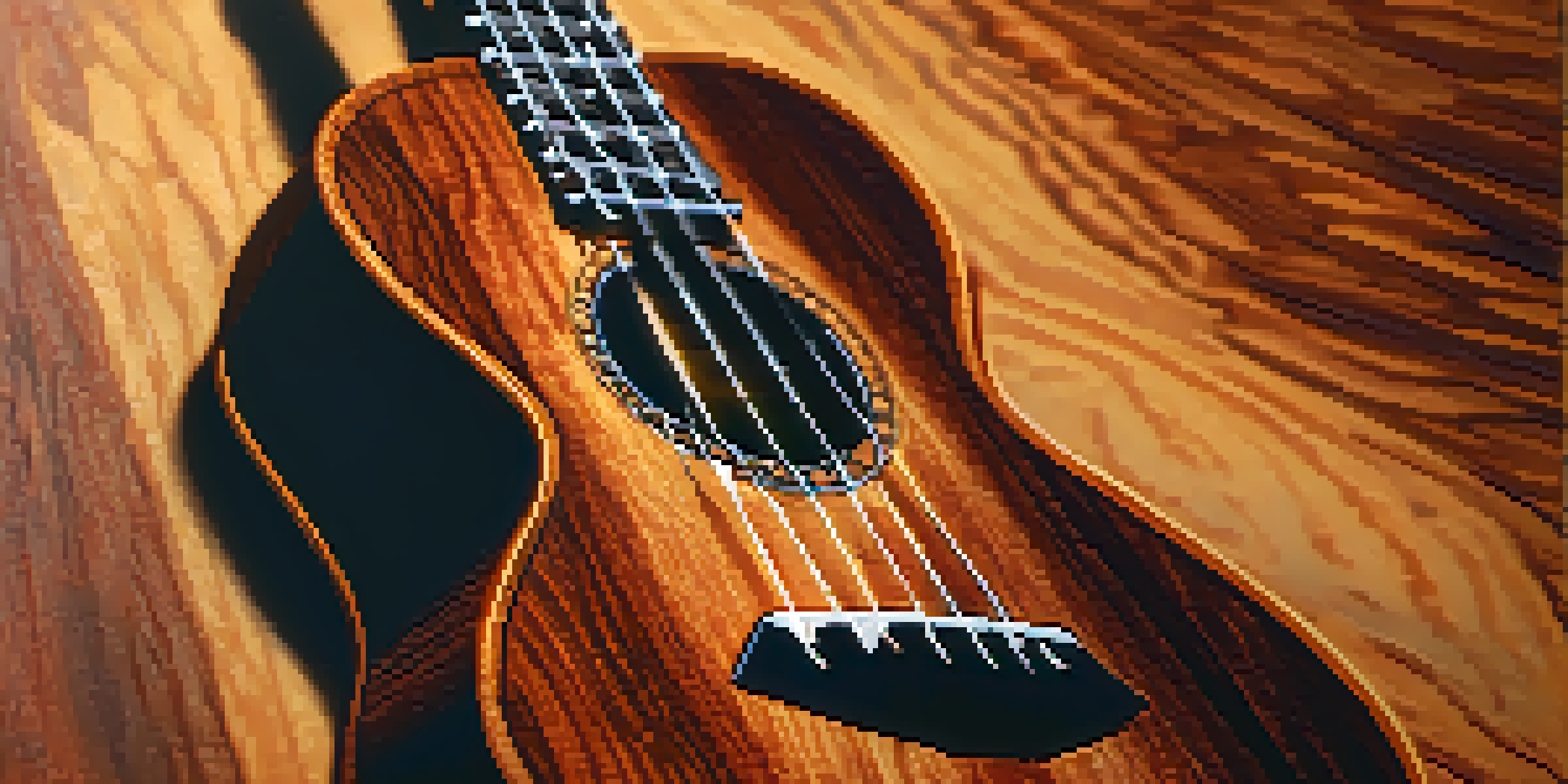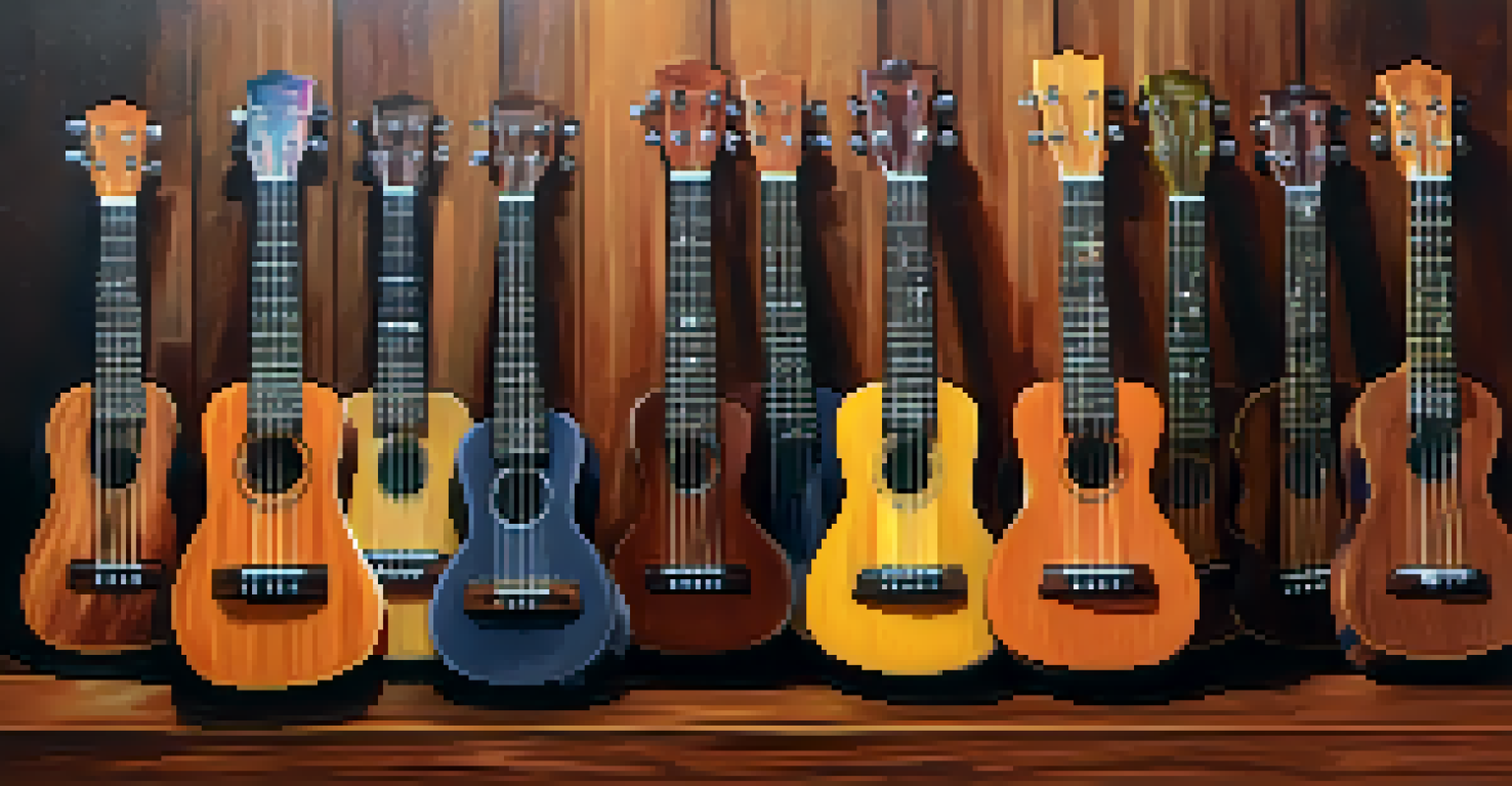The Role of Wood Selection in Ukulele Sound Quality

Why Wood Matters in Ukulele Construction
The choice of wood plays a crucial role in shaping the sound of a ukulele. Each type of wood has unique characteristics that influence tone, volume, and resonance. For instance, mahogany is known for its warm, mellow sound, while spruce offers a brighter and more projecting voice.
The beautiful thing about learning is that no one can take it away from you.
Think of wood selection like choosing the right ingredients for a recipe; the right combination can elevate the final dish to something extraordinary. In the same way, the wood chosen for a ukulele can drastically alter its overall quality. Musicians often spend considerable time selecting the right wood to ensure their instrument suits their style.
Ultimately, understanding how different woods affect sound can help players make informed decisions. This knowledge can lead to a more enjoyable playing experience and a more satisfying musical outcome.
Common Woods Used in Ukulele Making
Several types of wood are commonly used in ukulele construction, each contributing its distinct sound. For example, koa wood, native to Hawaii, is prized for its beautiful appearance and rich, complex tone. This wood can produce a warm sound with a hint of brightness, making it a favorite among professional players.

Similarly, cedar is another popular choice, known for its soft and warm qualities. Players who enjoy fingerpicking often prefer cedar for its responsiveness and clarity. On the other hand, laminate woods offer affordability and durability, making them great options for beginners.
Wood Choice Shapes Ukulele Sound
The type of wood selected significantly influences the tone, volume, and resonance of a ukulele, similar to how ingredients affect a recipe.
By exploring different wood types, players can find a ukulele that resonates with their personal style. Each wood brings forth unique sound characteristics that can inspire creativity and enhance musical expression.
The Impact of Body Shape on Sound Projection
While wood selection is significant, the body shape of a ukulele also plays a vital role in sound projection. The design of the body can affect how sound waves travel, leading to variations in volume and sustain. For instance, a concert ukulele typically has a larger body than a soprano, which can result in a fuller sound.
Music is the shorthand of emotion.
Imagine blowing into a balloon; the shape and size of the balloon impact how the air moves within it. Similarly, the contours of a ukulele influence the instrument's acoustics. Players should consider how body shape interacts with wood choice to achieve the desired tonal qualities.
Ultimately, finding the right balance between wood and body shape can lead to a more satisfying playing experience. Players who understand these elements are better equipped to choose an instrument that meets their musical needs.
Understanding Tonewoods vs. Laminate Woods
When it comes to ukulele construction, players often encounter the terms 'tonewoods' and 'laminate woods.' Tonewoods, such as mahogany or koa, are solid woods that are prized for their superior sound quality. They tend to vibrate more freely, producing a richer tone that resonates beautifully.
In contrast, laminate woods are constructed from layers of wood glued together, making them more affordable and resilient. While they may not offer the same depth of sound as solid woods, they can still provide a decent playing experience, especially for beginners.
Body Shape Affects Sound Projection
The design and body shape of a ukulele play a crucial role in sound projection, impacting volume and sustain during play.
Understanding the difference between these two types of woods helps players make informed choices based on their budget and skill level. Whether you opt for an exquisite tonewood or a practical laminate, each choice has its place in the world of ukuleles.
The Influence of Climate on Wood Sound Quality
It's fascinating to consider how climate can affect the sound quality of a ukulele. Wood is a natural material that reacts to changes in temperature and humidity, which can alter its tonal properties. For example, a ukulele kept in a humid environment may sound different than one stored in a drier climate.
Think of wood as a sponge; it absorbs moisture and expands or contracts accordingly. This fluctuation can lead to changes in sound quality over time. Musicians who live in areas with extreme weather conditions should be particularly mindful of how they care for their instruments.
By understanding the relationship between climate and wood, players can take steps to protect their ukuleles. Maintaining a stable environment helps preserve the instrument's sound quality and longevity.
Choosing the Right Ukulele for Your Playing Style
When selecting a ukulele, it's essential to consider your playing style and preferences. Different woods and body shapes cater to various genres and techniques. For instance, strummers might prefer a brighter-sounding spruce, while fingerstyle players may gravitate towards the warm tones of mahogany.
Imagine trying to play a classical piece on a ukulele designed for strumming; it simply won't produce the desired sound. This is why taking the time to understand your musical aspirations is crucial when choosing an instrument. Each ukulele offers a unique voice that can inspire creativity.
Personal Preference is Key
Finding the right ukulele involves personal preference, as individual tastes dictate what sounds and feels best for each musician.
By aligning wood selection and body shape with your playing style, you can find an instrument that feels like an extension of yourself. This thoughtful approach can lead to greater enjoyment and satisfaction in your musical journey.
The Importance of Personal Preference in Wood Selection
Ultimately, personal preference plays a significant role in wood selection for ukuleles. What sounds good to one player may not resonate with another. This subjectivity is what makes finding the perfect ukulele so exciting and personal.
Players are encouraged to try out different instruments to discover what feels right for them. The tactile experience of playing a ukulele, combined with the sound it produces, creates a unique connection that goes beyond technical specifications.

By embracing the subjective nature of music and sound, musicians can find instruments that truly inspire them. This journey of exploration can lead to a deeper appreciation of the art of music-making.